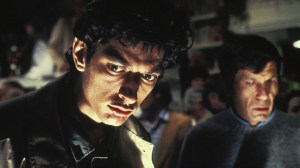When Shannon Lee decided to bring Warrior to light, she wanted to make sure it was done the right way, exactly as her late father anticipated. To do that, she enlisted the help of filmmaker Justin Lin and together, the duo decided to hire Jonathan Tropper to form the writer’s room behind the show. At the time, Tropper was producing Banshee for Cinemax, a Western that helped launch the career of The Boys’ Anthony Starr.
Videos by ComicBook.com
Once Tropper — himself a massive fan of the genre — boarded the project, the group was off to the races. Cinemax rushed to pick it up and after a hit first season, the network quickly ordered a second batch of episodes. That second season finally debuts on Cinemax beginning next Friday and in support of the long-awaited release, we caught up with Tropper over the phone, as he’s temporarily quarantined in Toronto, waiting to start production on the second season of Apple’s See with Jason Momoa.
Keep scrolling to see our full conversation with Tropper.
Ah Sahm & Season Two
ComicBook.com: We get to the end of season one, and Ah Sahm’s not in the best shape. That last episode, he’s beaten, broken, and battered. Where’s he find himself at the beginning of season two?
Jonathan Tropper: Well, we hint at the end of season one…the very last thing you see in season one is that he’s rejoining the Hop Wei. Season two finds him in the Hop Wei again, but in a much more aggressive and ambitious place than he was in season one. Season one, he was kind of like the new guy figuring everything out. Season two, he’s not very driven to make the tong as powerful as possible, because he wants to avenge that beating he took in season one. He wants to take out his sister’s tong. You find him much more aggressive and making moves to kind of bolster the power of the tong.
You say he’s going to be much more aggressive. Before, obviously, he kicks plenty of ass — but also he’s shown restraint at times when needed.
I would say season two is Ah Sahm unleashed, for sure. You’ll see that from the first frame of the first episode for season two.
Epic Fight Scenes
That’s the thing a lot of people talk about is that huge elaborate fight sequences. You’re sitting down to develop and write season two…was there a sense of urgency in saying, “We have to go bigger. We have to do more elaborate fight pieces?”
Not necessarily more elaborate, but we just have to make sure that we continue to raise the bar of what we’re asking of our fight coordinators. That’s the case, I think, on any show. For us, our fights always have to tell a story. You never want to just have token fights. You never just want to say we’re 15 minutes into the episode, it’s time for a fight, and just have people do a bunch of martial arts and have a fight.
Every fight has to come out of a character need, and every fight has to actually tell a story. Once you sort of make that your mandate, it becomes less about how do we top last season, and it’s more about who’s fighting with whom and what’s at stake. I think that’s really what fuels the fights as opposed to we need more flying kicks.
That said, we did say a big part of this show has to do with the iconography of Bruce Lee. It was really important to me that we continue to celebrate the iconography of Bruce Lee, so I made sure that somewhere in season two, Ah Sahm gets his hands on a pair of nunchucks.
You mention Bruce. I know you are a kung fu fiend, but is this the type of situation you require the room to go back and watch his stuff for inspiration?
No. I don’t think you need a room full of kung fu fiends, but I did have a room full of pop culture geeks and a room full of action movie geeks and people who really just appreciated some of the shoulders that the show was standing on. If I was ever talking about a particular moment that I wanted to use as an inspiration, right in the room, we would just find it on YouTube and project it onto the wall and discuss those things.
It wouldn’t be good if we were all kung fu fiends in the room. You need different kind of writers in the room. We had playwrights, we had genre writers, we had more character writers. It was kind of a mix.
You mentioned earlier, fights have to tell a story. I’d like to know more kind of about your process on that front. How in-depth are you for writing these scripts? Obviously, there’s a stunt coordinator, a fight coordinator, and all that. Do you script out every punch yourself, or do you leave it up in part to the coordinators?
I do script out every punch, but that doesn’t mean that’s what we shoot. I script out the entire fight so that my stunt coordinators get a very full understanding of what the story I want the fight to tell is. Brett Chan was our fight coordinator, and he’s one of the best in the business. Brett, in addition to his very strong martial arts background, he’s been doing this a long time, he has a really good understanding of the script.
What will happen is I will write out the whole fight, but those guys won’t just shoot what I write, because they’re much better at this than me, so they’ll take the intention… but by writing the whole thing out, I give them my intention. They’ll then take the intention and choreograph a much better fight.
It’s a collaboration where I’ll write it one way, Brett and Johnny will choreograph it a second way. I’ll look at what they’ve choreographed, make a few comments based on where I think maybe it’s moving away from something, and then we’ll end up with the final fight. It was a very easy and fluid collaboration.
Have you ever run into a situation where you scripted something so over the top they’re like, “No, we have to tone this down a bit?”
I’ve never heard any fight coordinator ever say to me, “We have to tone this down a bit.” Once in awhile, they’ll come to me and say, “The particular actor you’re writing for won’t be able to pull that off, and we want him to do this,” or “That scene you’re writing,”… I kind of had a rule, I didn’t want any wire work on the show. I felt that our martial arts had to be very grounded, and I would occasionally write something, and Brett would say to me, “That’s going to require a wire, but we can do this instead,” and he would show me something much more grounded, brutal, and cool. It was that kind of collaboration.
Once you’ve done the first few episodes, you get a pretty good sense of what you can and can’t write. My attitude was always to try to go for broke in the script and then let the reality come after that.
Future of Show
Before the second season officially started filming, Cinemax pulled the plugs on originals. Does that mean season two’s the end for Warrior? Do you guys plan on shopping it around at all? Is there a season three planned?
Right now, unfortunately, there is no plan for season three. The configuration of the whole HBO/Cinemax organization became such that Cinemax is not budgeted to make new shows, and they’re not budgeted to produce television anymore. We always have hope, but the way things are structured right now, we would have had to already have been shooting our third season, and we have not been. Currently, I don’t see a lot of hope for a season three, but I never say never.
One thing I did want to ask you, with the large sets in the show and such a focus on fighting, how do you think COVID’s going to impact all this stuff, hand-to-hand combat, and things of that nature?
Listen, all the shows that are coming back are coming back with tremendous safety protocols in place, but those safety protocols are designed so that by the time you get two or three actors in front of the camera, they have been screened and tested and kept safe, and at that point, they have to be able to function in front of the camera the way the would have before COVID. My feeling is if there is a show that doesn’t think they can pull it off, and it’s important to the show, they’re not going to come back yet.
Any shows that are coming back obviously feel that with the protocols in place, they can shoot the show the way they need to shoot it, more or less. Using large amounts of background and extras is problematic, and that becomes an issue, but to ask two of your actors who are properly quarantined, screened, and taken care of, then go onscreen and have to remain eight feet apart wearing masks, you’re not going to shoot that show.
I think the protocols are there to enable you to shoot that show, and these things have to be done carefully with a lot of protocols in place, but ultimately, if you need two people to fight on the screen, that’s what you’re going to have.
You just said you’re quarantined in Toronto for See. I think you have a movie with Ryan Reynolds and Sean Levy coming out sometime, right? What else are you working on?
You’re actually very well researched. That movie hasn’t shot yet. That movie’s going to be shooting in Canada shortly as well. What else am I working on? I’m working on season two of See is pretty much taking most of my time right now. I’m developing another pilot that I’m cowriting with Assaf Bernstein, who directed the pilot of Warrior. We’ve developed a pilot that we’re hoping to move forward. I’m also working on one or two other movie scripts. It’s just trying to stay busy.
You reminded me because of Banshee, and his is totally out of left field, but have you been watching The Boys?
Of course, I’ve been watching The Boys. It’s Antony. It’s a great show.
It speaks of his abilities being able to go from something like Banshee to Homelander and The Boys.
Yeah. It’s a really great role for him, and I feel like a proud papa watching him on that show. Even if he wasn’t on that show, that’s the kind of show I would have watched regardless, but it’s a great show.
*****
Warrior Season Two debuts on Cinemax October 2nd.
Cover photo by Nicholas Hunt/Getty Images








